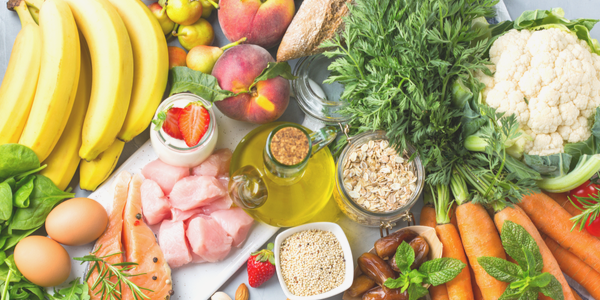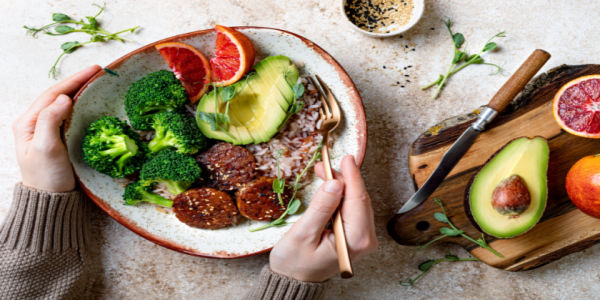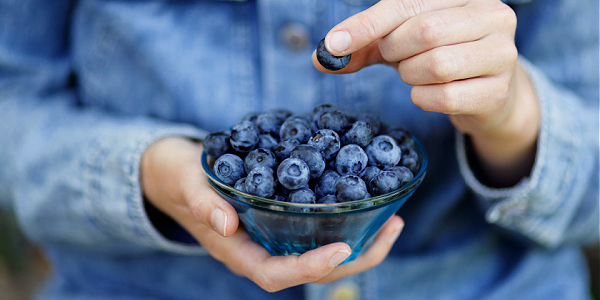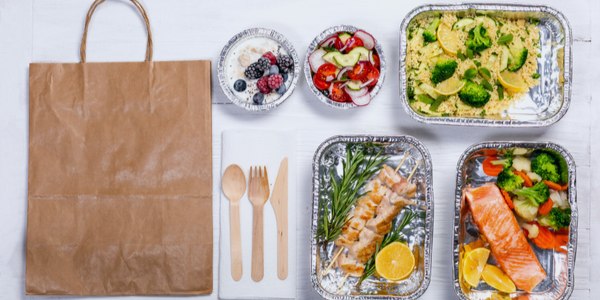
Keeping up with all the trendy and popular diets can be hard. Various diets rise and fall with popularity throughout the years, and some diets are simply unsustainable long term.
However, the DASH diet is different from fad diets. The DASH diet has research behind it that shows it is a healthy, long term eating approach to eating. In fact, the DASH diet was voted #2 best overall diet and #1 best heart health and healthy eating diet from US News and World Report.
So, what is so special about the DASH diet? Read on to learn more about what the DASH diet entails and simple tips for following this low sodium diet.
DASH Diet
Formally known as Dietary Approaches to Stop Hypertension, the DASH diet was developed by the National Heart, Lung, and Blood Institute in aim to reduce high blood pressure. Even if lowering blood pressure is not a primary concern, the DASH diet is a healthy plan to follow for overall health.
One of the surprising facts of the DASH diet is the simplicity of the eating plan. There are no special food combinations, cutting out food groups, or other radical eating approaches.
The DASH dietary pattern simply consists of eating the following foods and the respective number of servings:
• Grains and grain products: 6 to 8 servings, include at least 3 whole grain foods
• Fruits: 4 to 5 servings
• Vegetables: 4 to 5 servings
• Low- or nonfat dairy foods: 2 to 3 servings
• Lean meats, fish, poultry: 6 ounces or less
• Nuts, seeds, and legumes: 4 to 5 servings per week
• Fats and sweets: limited
(*Based on a 2,000 calorie diet)
The DASH diet is high in fruits, vegetables and emphasizes low and nonfat dairy. This focus helps increase intake of key minerals needed for blood pressure regulation: potassium, magnesium and calcium. Additionally, the DASH diet naturally emphasizes low sodium foods.
Low Sodium Foods
Cutting down on sodium is an important factor for lower risk for high blood pressure. Most Americans, on average, get about 3,400 mg (milligrams) of sodium per day, but it is recommended to limit sodium to 2,300 mg or less per day.
Following the DASH daily dietary pattern will naturally reduce the consumption of sodium. On DASH, sodium intake is recommended to 2,300 or 1,500 milligrams per day, depending on other factors such as current and past health conditions, age, and race.
Despite the absence of sodium in the foods stressed above, further limit sodium intake by:
• Limiting processed foods
• Removing the salt shaker from the dinner table and in cooking
• Choosing low- or no-sodium foods and condiments
• Watching out for foods that are cured, smoked, or pickled.
• Checking nutrition fact labels for sodium levels in foods and portion sizes
DASH Diet Health Benefits
Even if blood pressure levels are normal and healthy, the DASH diet is worth embracing. Reducing processed fats and sweets with rising amounts of fruits, veggies, and low-fat dairy products can ultimately provide overall health benefits.
Heart Health
As mentioned, the DASH diet helps to lower blood pressure related to its low sodium emphasis and increase of foods high in potassium, calcium, and magnesium.
The DASH diet also benefits heart health because it is high in fiber. Adequate fiber has been shown to reduce blood cholesterol levels.
Men should aim for 38 grams per day while women should obtain 25 grams per day. Interestingly enough, new research found the addition of higher fat dairy products actually reduced triglyceride and "bad" cholesterol levels in comparison to individuals consuming the standard low-fat DASH plan.
Additionally, blood pressure levels were reduced similarly following both diet plans. The compelling new findings offer DASH additional flexibility.
Weight Regulation
Although the DASH diet does not stress calorie counting, it is naturally a lower calorie meal plan. The DASH diet is made up of nutrient-dense, high fiber foods rather than calorie-rich foods. Therefore, the result of following the DASH diet can benefit weight loss and maintenance.
The DASH diet is a well-balanced diet filled with nutrients, an important key in the optimization of health. It provides success and sustainability due to its flexibility and its semi-unrestrictive nature making it a long-term dietary pattern to follow for weight maintenance.
Interested in further information on how the DASH diet can support weight regulation? Check out the book "The DASH Diet Weight Loss Solution."
DASH Diet Recipes
DASH diet-friendly recipes are primarily made up of fruits, vegetables, dairy, lean proteins, and whole grains making recipe options almost endless. Remember, the DASH diet is very high in fruits and vegetables. An easy way to start with a DASH diet is using recipes that incorporate produce as the main ingredients.
Examples of DASH diet recipes include:
• Baked cinnamon apples for a healthy but sweet dessert or snack.
• Whole wheat penne with vegan alfredo sauce leaves out the heavy cream, milk, and butter while using whole grain pasta.
• White bean salad with spinach, garlic, and sun-dried tomatoes as a simple but delicious lunch or side dish to any meal.
• Cauliflower gratin with feta and olives is a great way to combine a vegetable and low-fat dairy in the same dish.
• Couscous salad and Mediterranean quinoa are more easy salad options for lunch or dinner that combine vegetables and whole grains.
• Tuna pita pockets are a DASH diet-friendly meal that is low in sodium and high in protein and fiber.
• Healthy yogurt bowls for breakfast provide a high protein breakfast that provides a source of dairy and various fruits.
More recipes can be found at both the Mayo Clinic and the National Heart, Lung, and Blood Institute websites.
DASH Diet Meal Plan
If following the DASH diet seems cumbersome to count how many servings of each food group, making a DASH diet meal plan can help make it simpler. A meal plan can include writing out meals for the week, simply making small changes to your current diet, or anywhere in between.
For example, simple switches to a DASH diet meal plan can include the following:
• Add one extra vegetable or fruit to every meal.
• Incorporate meatless meals once a week (or more) that use legumes, nuts/seeds, or whole grains as a protein source.
• Rely more on fresh or dried herbs and spices for flavoring instead of salt or soy sauce containing high amounts of sodium.
• Drizzle heart-healthy olive oil atop salads as opposed to salad dressings that tend to be laden in added salt, sugar, and unhealthy fats and oils.
• Switch to whole grains like brown rice in place of white rice, refined flours, and bread.
If a detailed DASH eating plan is desired, the National Heart, Lung, and Blood Institute has a week-long DASH diet eating plan that breaks down each meal for the week with the sodium levels of each food.
Recapping the DASH Diet
The DASH diet is not only a way to help reduce blood pressure, it is an overall healthy diet anyone can follow including for weight loss. It is not just another fad diet and has research behind the principles of the diet showing positive health outcomes, mainly with lowering blood pressure.
The DASH diet lowers sodium intake to 1,500 to 2,300 mg per day compared with 3,400 mg average daily sodium intake for most Americans. The diet also emphasizes a higher intake of fruits, vegetables, low-fat dairy, whole grains, and moderate lean protein intake. It also limits red meat and sweets.
Overall, the DASH diet is a sustainable diet that has endless options for recipes and meal plans!
References
Dash Diet. U.S. News & World Report. https://health.usnews.com/best-diet/dash-diet.
The DASH Diet. https://www.dashdiet.org/.
Center for Food Safety and Applied Nutrition. Sodium in your diet. U.S. Food and Drug Administration. https://www.fda.gov/food/nutrition-education-resources-materials/sodium-your-diet.







